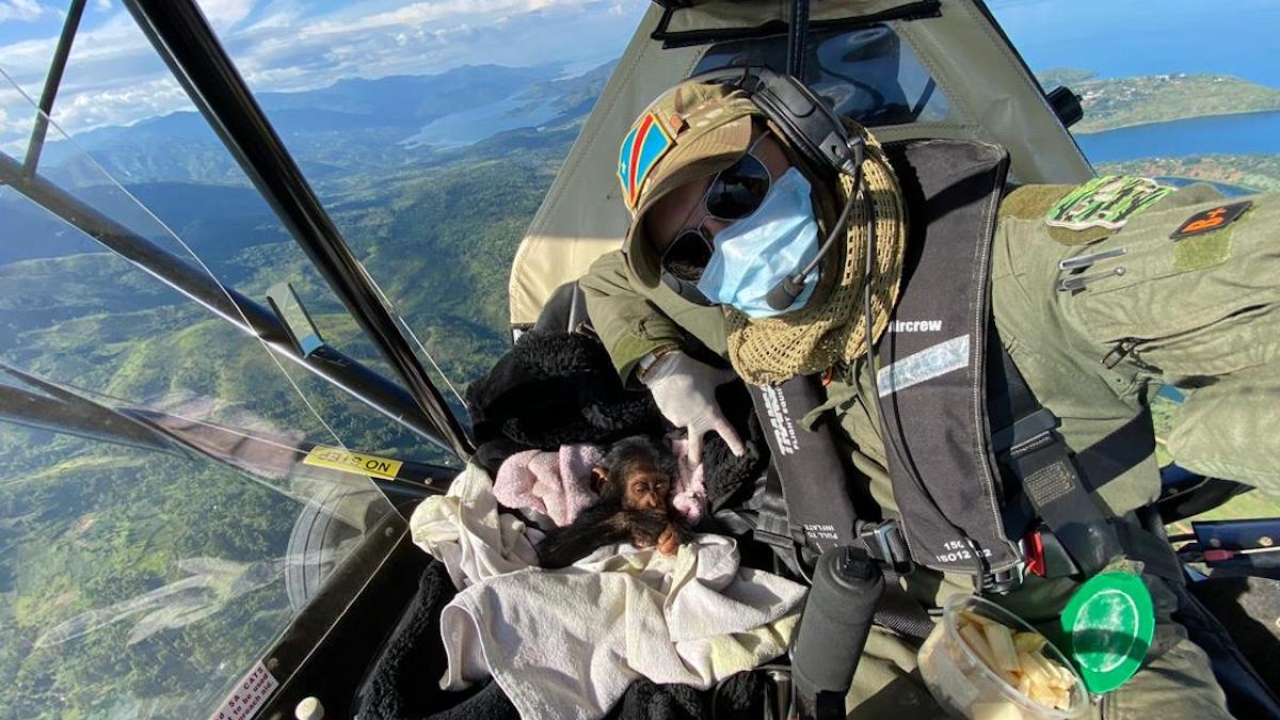A flight on the wild side
As head of Virunga National Park’s Air Wing programme, Anthony Caere is a pilot with a plan - to protect the park and the animals living in it one flight at a time.

HEALTH CAERE: Anthony Caere in the cockpit with a chimp. Image: LCA Air Wing/Anthony Caere
It’s not every day you come across a chimpanzee in the cockpit, but for Anthony Caere it’s not that unusual. Head of Virunga National Park’s (VNP’s) Air Wing programme, the 43-year-old Belgian born pilot has been living in the Democratic Republic of Congo (DRC) for the last 11 years.
“I came originally to work as a pilot on a television documentary about flying doctors. It was on this trip that I met the conservationist and anthropologist Emmanuel de Merode, the director of VNP, and we donated the Cessna 206 we were using to his project.”
There was one small snag. Merode needed a pilot. “He asked me if I wanted to stay and that was that!” Caere told African Aerospace. “We started up VNP’s Air Wing with one Cessna 206 to help monitor and protect the park and the wildlife living in it. We now have 10 aircraft, thanks in large part to the support of US-based non-profit organisation, Last Chance for Animals (LCA).
In addition to the Cessna 206, Air Wing’s fleet includes a Cessna 182 and Bat Hawk aircraft.
Designed with surveillance and conservation work in mind, the Bat Hawk’s half open cockpit is similar to that of a helicopter and provides excellent forward visibility either side of the cockpit.
Alongside a handful of expats, some of VNP’s rangers have now also been trained as pilots. “Following a rigorous selection process, we currently have three Congolese pilots working for the Air Wing.
“We’re also looking to build additional airstrips and incorporate modern technology in our aerial surveillance work, including the use of Artificial Intelligence to help identify, gather and analyse data on wildlife populations more efficiently.”
As head of the Air Wing, Caere’s typical day involves a fair amount of administration and scheduling of flight operations. He is also tasked with overseeing maintenance of the Bat Hawks and securing spare parts.
Given the Bat Hawks ability to land in remote locations on air strips of just 250-300m long, the aircraft are also used to transport equipment and supplies, as well as for medical evacuations.
Caere noted that medical emergencies can range from rescuing rangers from rebel attacks to injuries from snake bites.
“Time is of the essence when getting these victims to safety, so medevac services are at the core of our work,” he said, revealing he has lost 72 colleagues in the last 11 years.
Some of the aircraft are also equipped with a large DJI - Matrice drone and cameras which are used to take pictures every three to five seconds of the ground below. These thousands of images are then stitched together to provide a crystal-clear, high-definition image of the park.
“We often rescue orphaned infant chimpanzees. They are traumatised, as most if not all of their family will have been killed in order to get just one baby, which if it’s smuggled out of the country can be sold for as much as US$20,000.
“So, before we fly them off to safety, we spend time with them to form a bond and keep them calm.
“They are like human babies, so once you’ve built up that trust, it’s easy to wrap them in a blanket and keep them safe and warm in the cockpit with you,” he said.
Being an Air Wing pilot in VNP is certainly not for the feint hearted. “We operate in extremely challenging and frequently dangerous situations,” said Caere. “Often the airstrips themselves are short and difficult to land on.”
Given his time again, would Caere have pursued a more conventional career as a commercial pilot? “Since I was a child, the only thing I ever wanted was to fly and work with animals. So, for me my work is a dream come true.”
It's a job he was clearly destined for as he concluded: “Nothing is more enjoyable than flying a Bat Hawk at a low altitude over the VNP with a big herd of elephants below, the sun setting on the horizon and music blasting through my Bose headset!”
Stay up to date
Subscribe to the free Times Aerospace newsletter and receive the latest content every week. We'll never share your email address.


